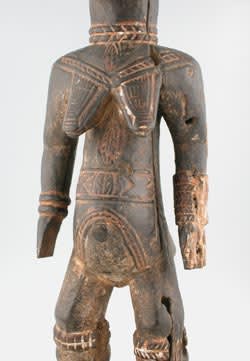Bassa Wooden Sculpture of a Woman, 20th Century CE
Wood
4.75 x 18.125
PF.5920
Further images
The Bassa, one of the largest Kru-speaking peoples in the central coastal region and adjacent hinterland of Liberia, have been strongly influenced by the Mende-speaking neighbors, specifically the Dan. Their...
The Bassa, one of the largest Kru-speaking peoples in the central coastal region and adjacent hinterland of Liberia, have been strongly influenced by the Mende-speaking neighbors, specifically the Dan. Their economy is based on rice that they cultivate around small villages which each have a population of around two hundred people. Stylistically, this sculpture is heavily indebted to the sculptural characteristic of Dan figures. The posture and proportions of this stunning sculpture is almost a direct quote of similar Dan examples from the position of the limbs to the layout of the facial structure. No doubt the visage of this woman is drawn from the Gela masks that Bassa artists are famous for. These masks, also influenced by the Dan, displays a characteristic two-planed face with a protruding mouth semi-closed eyes and represent idealized forms of feminine beauty. In the Dan tradition, this type of figure was commissioned by powerful chiefs as three-dimensional portraits of their favorite spouse. These sculptures are kept hidden inside houses and are only revealed during important occasions such as visits by foreign dignitaries. They also function as maternity figures as suggested by the figure’s swelling belly and elongated breasts. Based on both the striking similarity and general rarity of these figures, if is same to assume that they functioned much the same between the two tribes. Perhaps the most stunning feature of this masterpiece is the elaborate decorative scarifications that cover almost all of her torso, front and back. These scars both accentuate her tremendous beauty and convey her status and rank within the Bassa tribe. Certain patterns, such as the vertical band carved along her nose and forehead, are characteristic of the Bassa and would clearly identify her as a member of this tribe. Overall, the heavily encrusted patina that blankets this work attests to its ceremonial significance within the tribe. This sculpture was created to commemorate the spouse of a chief and to immortalize her beauty. Today, she continues to captivate all who gaze upon her.







